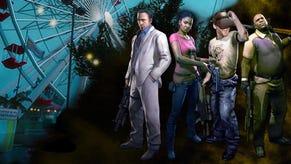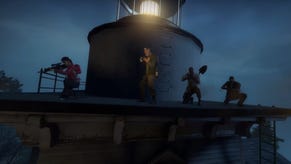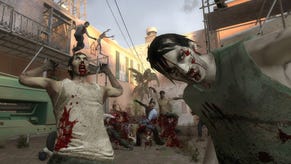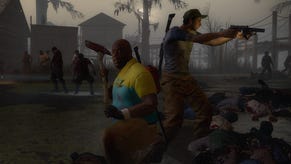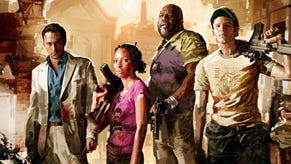Left 4 Dead 2
Valve's Doug Lombardi on frying pans and forum wars.
That's one of the reasons we went for a sequel. We realised people were kind of gaming the game, particularly with that backing-up-against-the-wall stuff. So for one thing, we're redesigning the finales, and turning them into scenarios where we put you on the run: you have to keep moving, or you'll get overloaded. Then there's new bosses like the Charger - that big wild arm, that's to bat you around and move you about. You can pretty much be guaranteed that if you wedge yourself up against a wall, you're going to see a Charger pretty quickly, and he's going to swat you away.
There's always going to be a level where, when people get 100 hours in, they're going to discover a way to game the game. That's fine. And then we'll figure out how to counter it again, and give them something else to figure out how to break.
It's something we're toying with. In New Orleans, the coffins are above ground, so you have these mini mausoleum buildings, for example: the first time you go through, the mausoleum will be laid out in a certain way, and the next time it will be different. It's not quite random level generation, but it is doing things with world objects and pathing to give you one more thing to keep you on your toes. Another thing is weather effects. When you're in the swamp for example, you're up to your waist a lot of the time, and one thing we might do is roll in fog effects, so you've got enemies coming at you from ten feet of visibility. Obviously, only if you're doing well will you see that, but it's another way to tailor to people's skill set.
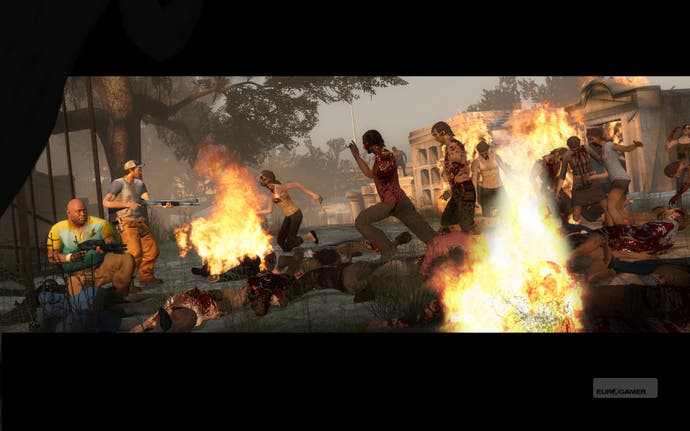
The AI director - I don't want to say it fell out of Half-Life 2, but it was definitely a jumping-off point of stuff we did in Half-Life 2, particularly Episode 2. There are a couple of key battles where the number of Combine, and where they come at you from, uses something like that. It's much cruder than what we accomplished with Left 4 Dead, but there was some of that there. I think you can definitely extend that. You're still going to have that moment where you need those big Half-Life and Modern Warfare set-pieces where there's got to be some hand-stitching: by nature, that's going to be the same each time you play it. So it's weird: you're mixing replayable sandboxes with these climax moments which aren't going to have that - at least for the foreseeable future. I don't know to what extent that's enjoyed by the consumer. I don't know how many times people would be willing to play the single-player part of the experience.
My hunch is that, in the case of Half-Life, or Half-Life 2, or Modern Warfare, there's a chance that a higher proportion of people finish those games because the combat didn't feel like a shooting gallery and the climax were really satisfying. But my hunch is that people finish those games, and then they don't say: "Wow, that was so good, I want to play it again." I haven't spoken to people who have said, "I wanted to play Half-Life 2 ten times." Instead, they want to find out who the G-Man is.

Yes, I think part of the fun is definitely the secret part of it, letting the community find stuff and theorise. There have definitely been people guessing what was going to happen, say, before the episodic games come out. It's funny because a couple of people are really on the money, a couple of people are just totally out there. It's fun for us to watch that, and, of course, it encourages us to be more misleading and mysterious about stuff.
There's a little bit of both aspects. You have to have basic direction, and basic groundwork: Freeman's relationship to the G-Man and that sort of stuff. But things like the decision to axe [a major character] at the end of Episode 2, that wasn't planned when we were making Episode 1. You have to allow yourself that freedom, both in terms of story and the basic gameplay. I mean, Ravenholm was at the end of Half-Life 2, and then we were playtesting with outside people and they were saying, "Wow, this gravity gun's the best thing in the whole game!" so we were like, "Ahh, Ravenholm's the second chapter in the game now!" I don't think we planned to keep Al around or as prominent after Half-Life 2, but as soon as we showed it, people just gravitated towards her, so, okay, she's going to play a bigger part as we go on. You have to be able to respond to what people want. You want to see what the common themes are that resonate, and then turn up the volume.
Nope! [Laughs.] I really can't say anything. We're always trying to do new stuff with every game we put out, but beyond that there's really nothing I can say.
Doug Lombardi is vice president of marketing at Valve. Left 4 Dead 2 is due out for PC and Xbox 360 on 20th November, and we'll have a more extended hands-on soon.

